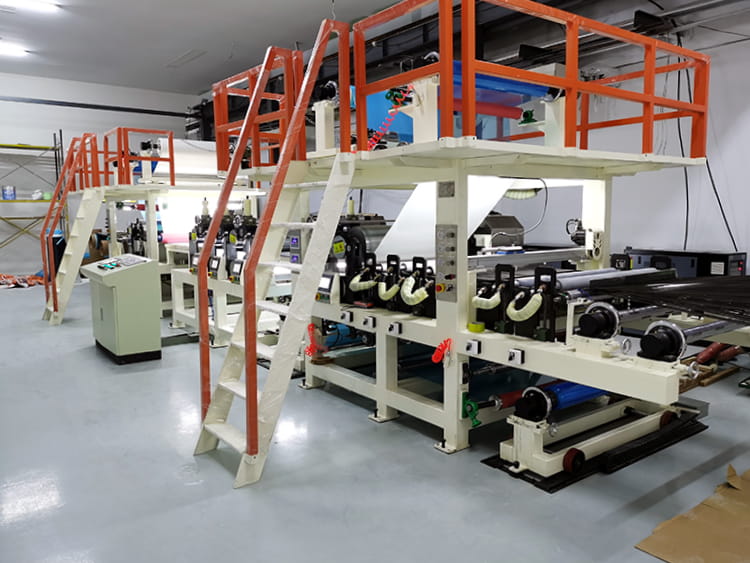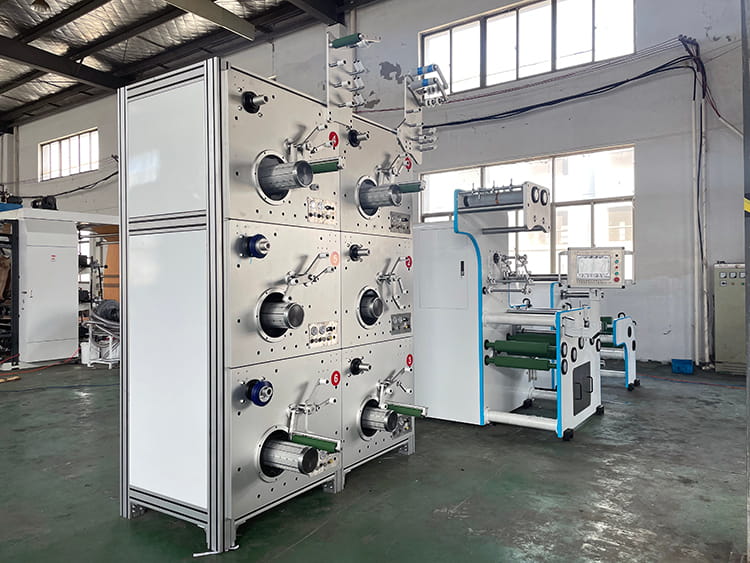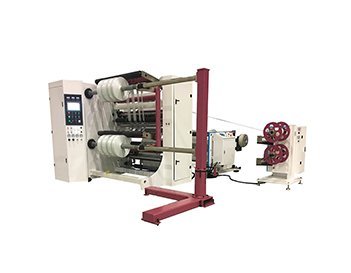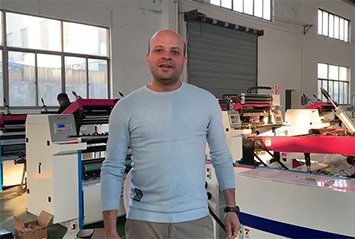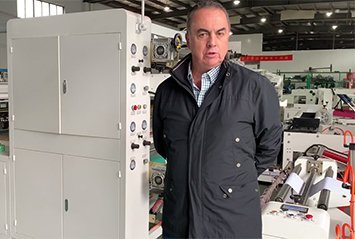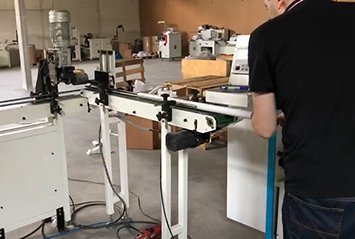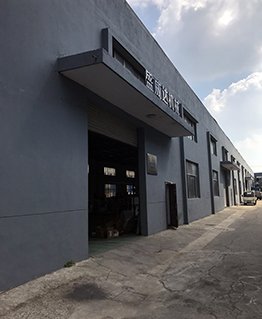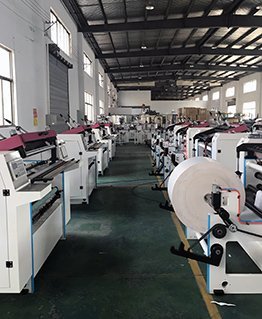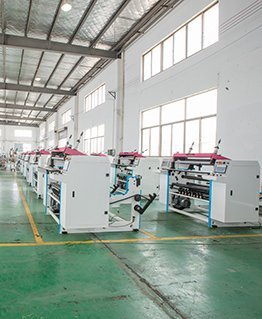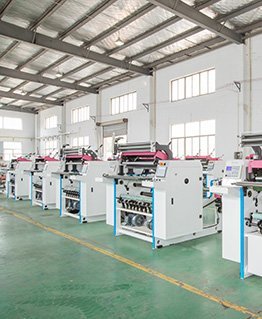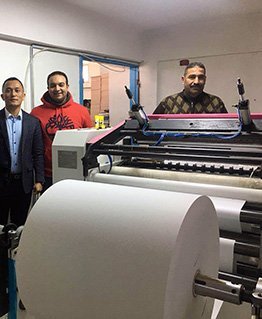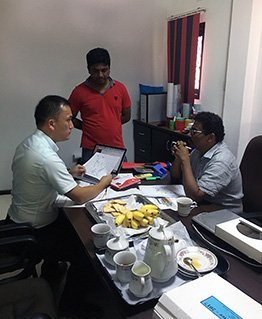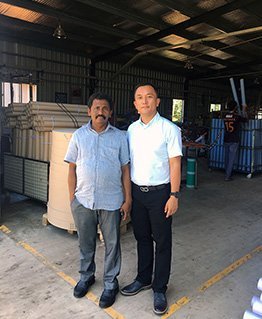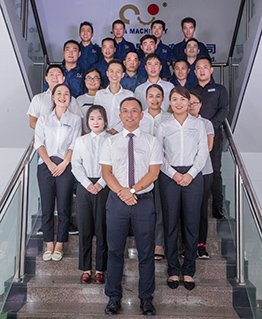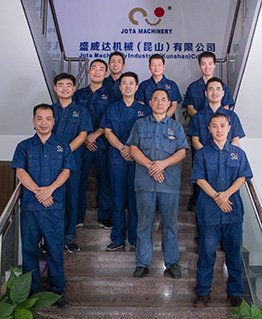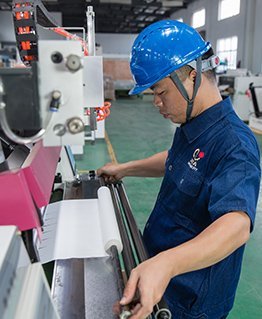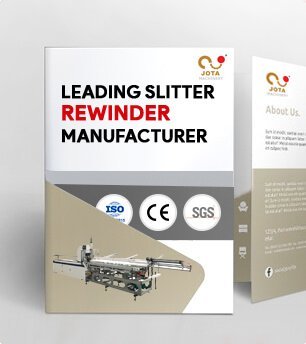Newest Prepreg Technology
- Leading Thermoplastic Nylon + Carbon Fiber Prepreg Production Line Manufacturer
- High Advanced Technology And Equipment
- One-Stop Service
- Professional Team for Machinery and Resin Applications
Nylon + Carbon Fiber Prepreg Production Line
In 2021, our composite products will extend from the original continuous thermoplastic fiber-reinforced UD tape line, unidirectional tape slitting traverse spooling machine to the automated fiber placement technology used in aerospace.
We provide not only equipment but also a mutually beneficial overall solution. Please contact us if you need any assistance.
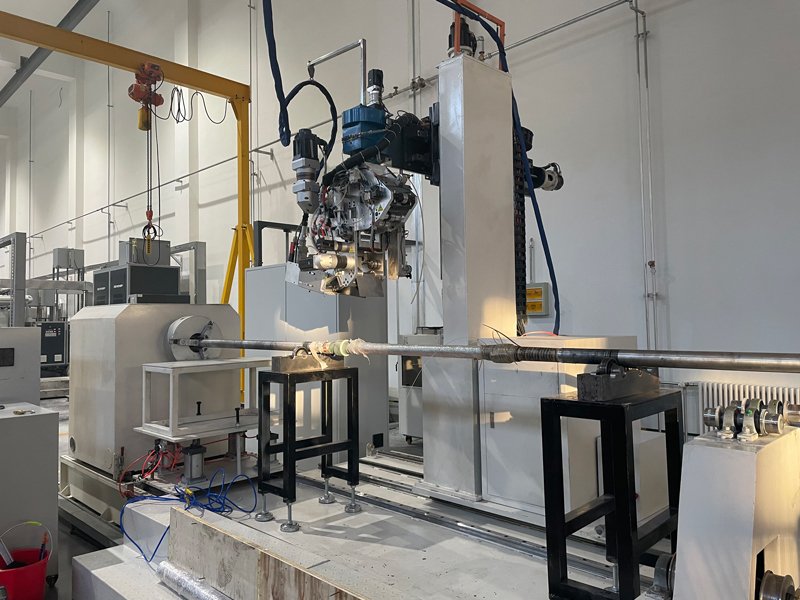
Your Best Choice Hotmelt Thermoplastic Nylon + Carbon Fiber Prepreg Production Line Supplier
Jota is able to manufacture 30 sets of Hotmelt Thermoplastic Nylon + Carbon Fiber Prepreg Production Line equipment in 1 month with our own CNC center.
Foothold wall and precision parts could be made by ourselves, machine quality could be guaranteed.
You could just send some prepreg Unidirectional Tapes or composite Tapes to us, we could test it, then share the testing video with you.
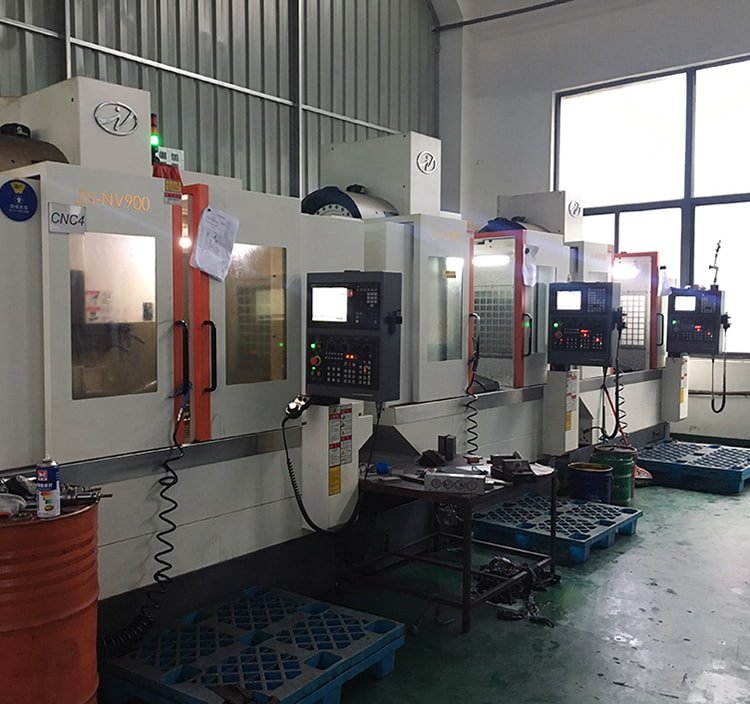
Jota CNC Center
Machining Material
- Visible high-quality components.
- Famous brands such as Siemens, Yaskawa, Delta, Schneider, Mitsubishi.
- Self-supporting CNC processed sheet metal, precision parts.
- Assembly raw materials provided by long-term cooperation suppliers.
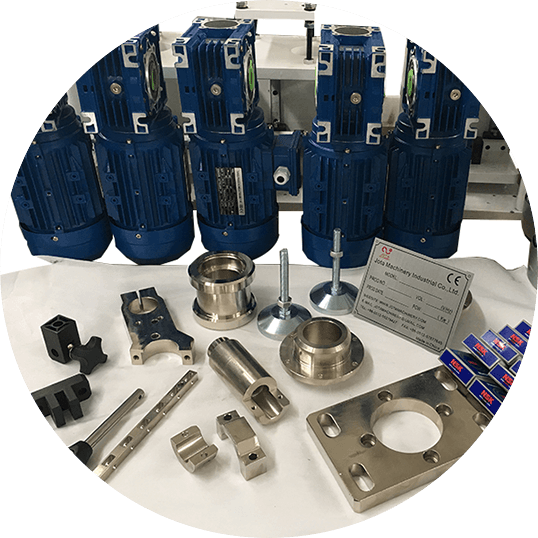
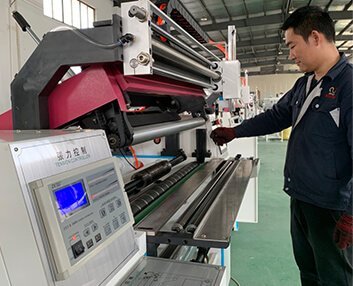
Installation and operation user manual, wire connection diagram, tension controller guide.
Installation and operation video tutorial.
One-on-one remote video call assistance.
On-site installation and operation guidance.
- Focus Factory
- Dear Customer
- Professional Team
Around 45-90 days, mainly depends on the machine type.
Sure, it is our honor to work for you.
We will offer you some parts as backup, in case any part is broken within one year, we will sent you for free.
Sure, if we have client in your country, we will offer.
Hotmelt Thermoplastic Nylon + Carbon Fiber Prepreg Production Line
Nylon is commonly used in making products that are water-resistant and lightweight.
Denoted as PA6 or PA66 or PA56 or PA11 etc., nylon is a thermoplastic whose applicability is a wide range and versatile. Examples of products where it’s applicable include: reinforcing rubber parts of car tires, rope, gears, bushings, bearings, etc.
Nylon is preferred for its low-friction properties. And when reinforced using carbon fibers, it results in an improved version where it can withstand high temperatures.
The combination of having plastic-like features whilst maintaining or withstanding high temperatures makes fiber-reinforced nylon a perfect material.
This makes it a great substitute for metals in environments where high temperature is of the essence; for example, under a vehicle’s hood.
With an enhanced strength due to prepreging, a PA6 or PA12 nylon becomes the best choice material for engine components. This is thanks to the fact that it’s resilient to high temperatures and resistant to chemicals.
Jota’s Nylon Prepreg
However, such great features are only achievable due to prepreg process. And that’s where Jota Machinery comes in. We specially upgraded technology in pre-preging nylon + carbon/glass fiber prepregs.
We have an advanced Nylon + Carbon Fiber Prepreg Production Line that works perfectly well with all kinds of polymers and resins, which include PA6, PA12, PA56, PA66, and PA11 nylon applications.
At Jota Machinery, our Nylon + Carbon Fiber Prepreg Production Line uses the hot melt method, which is not only effective in making sure you have the right nylon applications resins, but also helps you come up with the appropriate designs as per your product’s requirements.
What’s a nylon prepreg? How’s it produced? Is hot melt the best nylon prepreg method? What’s carbon fiber reinforcement? Why is nylon prepreg so important? Where is it applied?
There’s so much to know about thermoplastic nylon + carbon fiber pre-pregnations. And the best way to understand these questions is to look at it from FAQ perspective.
So let’s go ahead and do that.
What’s a Prepreg Nylon + Carbon/Glass Fiber?
Generally, prepregs UD tapes are made by reinforcing carbon/glass fiber with a thermoplastic resin polymer like nylon.
Since prepregs are cured under high temperatures and pressure, they have unique properties that enhance their strength and stability. Because of this, pre-pregnation Unidirectional Tapes are used in manufacturing a wide range of products.
For example aerospace, and aircraft as well as construction field.
A nylon + carbon or glass fiber prepreg Unidirectional Tape is exceptionally strong, long-lasting, elastic, easy to wash, and resistant to both abrasion and chemicals.
These improved properties make the reinforced nylon + carbon/glass fiber prepreg UD tapes on high demand. And to make things even better, since nylon is a thermoplastic (and not a thermoset), its reinforced version is reusable – it can be heated and cooled down again for reuse without losing its quality.
At the same time, the nylon + fiber prepreg can be stored in a cool place to prevent its complete polymerization. Such a B-stage nylon prepreg can, later on, be heated on an autoclave oven during a manufacturing process, hence full polymerization.
It’s worth noting that the reinforced nylon plus carbon or glass fiber is made either as a UD (unidirectional) tape or as a woven fabric. This, of course, depends on the kind of product requirements the manufacturer needs.
What’s Nylon Prepreging Process?
Since prepreging is the process of pre-impregnating a resin with a carbon or glass fiber, nylon prepreging is the process of reinforcing nylon using carbon/glass fiber.
When it comes to prepreg manufacturing methods, there are many methods – hot melt and solution dip and so on. Today we focus on the hotmelt thermoplastic Prepreg methods.
-Hot Melt Prepreg Method
This is the prepreg method Jota Machinery uses. As mentioned earlier, the method doesn’t use any solution to mix up the two materials (nylon + carbon fiber) for prepreg.
Jota Machinery uses a double screw co extruder for the Nylon polymers like PA, PA, PA56, PA66, and PA12, under the use of the high temperature at Max. 380 degree, the Nylon polymer would be melting as a liquid. It is flowable.
Then the melting Nylon polymers will be injected into the prepreg molds, where it will be prepreged with Carbon Fiber or glass fiber, under the help of the high temperature and high pressure. The prepreg molds is also the key technology for one supplier.
Then after the exit of the prepreg molds, the Unidirectional Tape is extruded, mainly the UD tapes thickness is around 0.25 – 0.30mm
After the calendaring roller, the UD tapes will be calendered and be formed, then rewind into big rolls. That is the UD tape you want.
——————————————–
What are the Advantages of Nylon Prepregs?
Well, it’s obvious that nylon prepregs come with their upsides, mainly it’s about improved quality of the material to withstand harsh conditions. Here are some of the advantages of a nylon + carbon/glass fiber prepreging process.
1. High Precision
Since the tooling and the parts are both composite materials, their thermal expansion coefficients are similar.
In the heated state, the two heat up or cool at the same rate, so the part deforms less in the solidification and subsequent processing steps.
The accuracy of the finished product is greatly improved, and the repair and troubleshooting work is reduced after heat treatment.
2.Maximum Strength Characteristics
A typical manual layup will have a large excess of resin, which will increase the brittleness and reduce overall performance.
Most prepregs contain about 3% resin, which is ideal for achieving maximum curing performance, which cannot be achieved with conventional manual lamination.
3. Uniformity and Repeatability
The thickness of the prepreg is uniform, and each part coming out of the mold may theoretically be the same.
Vacuum bagging technology still has certain errors in processing molds, but prepregs can greatly reduce these problems.
4. Reduce Curing Time
After the heat curing cycle, there is no need to wait the standard 48 hours to fully cure.
5. Good Appearance
Although prepreg processing still requires mold preparation and demolding, prepreg processing can eliminate air bubbles and make it easier to obtain a smooth and shiny surface.
Where Is Reinforced Nylon Prepreg Applicable?
Nylon’s applications are wide range. It’s used in making engineering components, automative parts, kitchen appliances, and sports equipment.
In engineering, carbon fiber-reinforced nylon materials (specifically PA11 and PA12) are used in making gears, plastic bearings, and bushings. This is thanks to its low-friction capability and greater dimensional stability.
Nylon is also used in making housings for power tools, which helps protect the tools from adverse chemical and mechanical conditions.
In the automotive industry, the PA66 nylon is used in producing components such as vehicle door handles, fans, and filters.
Similarly, the reason for its application in automotive parts is due to its low-friction property. And the fact that it can withstand abrasion hence lasting many years without needing to replace the automotive parts.
In sports, nylon + carbon fiber is used in manufacturing equipment such as racquet frames and shuttlecocks.
Additionally, reinforced nylon has the capability to maintain flexibility over high temperatures, hence its use in cable ties and battery cases. This is specific to the likes of PA11 and PA12, which offer better flexibility than PA6 and PA66 nylon materials.
Reinforced nylon also comes in handy in our homes. Once again, because of its capability to withstand abrasion and tolerate high temperatures, nylon is found housing of kitchen appliances. It’s also used in making components of vacuum cleaners.
Other applications of nylon-carbon fiber prepreg include:
- Reinforcing rubber materials on car tires
- Ropes and threads
- Molded vehicle parts
- Fashion bags and clothing
It’s worth noting that reinforced nylon doesn’t offer the best slippery, low-friction properties. If there’s a need for low friction as the only requirement, then acetal is a high recommendation.
However, carbon fiber + nylon prepreg is the best and most appropriate when low-friction and the need to withstand high temperatures are the product’s requirements.
That is, nylon prepregs like PA12, PA11, PA6 and PA66 are great choices for products that are likely to experience a lot of wear and abrasion.
Why Nylon Reinforced with Carbon Fiber Is Important? When Is It Needed?
As we’ve already mentioned, carbon fiber-reinforced nylon is mainly needed where the target product is supposed to be strong, resistant to chemicals, offers dimensional stability, and can withstand abrasion.
Reinforced nylon is important because the carbon fiber improves quality of the prepreg material.
Using impregnation as a way of reinforcing nylon, the outcome product is usually better in terms of:
- Increased stability when exposed to high temperatures
- Improved hardness where the reinforced nylon version is 50 times harder than the standard nylon.
- Low-friction capability where the reinforced nylon offers better slippery properties.
- High resistance to abrasion so that it can withstand wear and thus last longer, hence longevity.
Despite its many benefits as a product material, nylon has its downsides. Relatively, it doesn’t offer high-impact strength. Nonetheless, this can be improved through a process known as “conditioning” which improves nylon’s mechanical strength.
As a result, nylon is useful in various plastic applications whose requirements are to offer plasticity and high melting temperatures.
Basically, the reinforced nylon is perfect for use in scenarios where the product is supposed to withstand chemicals, stress, heat, and any other harsh conditions.
Here’s a summary of the advantages of carbon-reinforced nylon:
a. Thermal Tolerance
Once reinforced, nylon’s thermal expansion rate is about half of normal, standard nylon. This means it’s going to withstand deformations due to abrupt weather and temperature changes.
b. Stiffness
Reinforced nylon usually features a stiffness property of 80 percent more than a regular nylon. This makes the prepreg material useful in making products that need to withstand strong mechanical exposure.
c. Durability
Nylon that’s been reinforced using glass fiber offers up to 70 percent more tensile strength compared to an unreinforced nylon. This means the nylon + glass fiber prepreg can withstand stress without breaking or bending.
How Are Carbon-Reinforced Nylon Prepreged?
Fiber-reinforced prepregs are pre-impregnated with homogeneous material with the objective of forming an improved version of either material being pre-impregnated.
Nylon-fiber prepregs are possible by applying heat and pressure through hot melt or solvent dip prepreging methods.
The prepreg material can further be decorated by painting, hot foil stamping, plating, silk screen printing, laser printing, and vacuum metallization.
At the same time, it’s possible to combine the components (resin + fiber) by using ultrasonic welding and a two-part epoxy adhesion.
Let’s have an in-depth examination of the different prepreg methods we employ at Jota Machinery.
Basically, nylon + fiber prepregs are reinforced using various methods depending on the type of product that’s to be manufactured. The main processes are as follows:
- The vacuum bag process is mainly used in the decoration of the shipbuilding industry railway system
- The autoclave process is mainly used in high-quality composite materials
- The molding process is mainly used in flat panels, sporting goods, sleds, and industrial products
- The tube rolling process is mainly used in fishing poles, ski poles, golf clubs, and pipe fittings
- The pressure bag process is mainly used in masts, antenna poles, and various pipe fittings
Now let’s go ahead and explain each prepreg method further, especially in terms of advantages, disadvantages, and procedural steps taken.
1. Vacuum Bag Process
The vacuum bag molding process is a molding process in which the product is sealed between the mold and the vacuum bag.
The product is then pressurized by vacuuming so that the it’s more compact and has better mechanical properties.
Advantages of vacuum bag process
- High fiber content, better mechanical properties of the product
- Uniform pressure, uniform product performance
- Effectively control product thickness and glue content
- Reduce bubbles in the product
- Complicated and large parts can be formed
- Reduce the damage to personnel caused by volatile matter
Here are the procedural steps in a vacuum bag prepreg process.
Step 1: Mold preparation, apply release agent
Step 2: Product layering (hand lay-up, spraying, prepreg)
Step 3: Spread the release cloth
Step 4: Pave isolation film or isolation film with holes (may not be laid)
Step 5: Spread air felt
Step 6: Paste the sealing tape (can be advanced)
Step 7: Sealing vacuum bag film
Step 8: Install vacuum valve, quick connector, and vacuum tube
Step 9: Connect the air source to check the vacuum
Step 10: Vacuum and solidify the product
Step 11: Product demoulding
2. Autoclave Forming Technology
Features:
Uniform pressure in the tank, fast, uniform air temperature in the tank, high precision, high quality, wide application range, suitable for batches, reliable molding process;
Disadvantages:
High cost and large initial investment
3. Roll Forming
Roll forming is mainly borrowed from metal forming methods.
The equipment consists of a series (one or more groups) of hot pressing rollers and cold pressing rollers.
After being heated, the paved prepreg is first passed through a set of hot rollers to deform the prepreg and then passed through a set of cold pressing rollers for forming.
The pitch of such a cold-pressing roller gradually shrinks.
Advantages of roll forming
- The green body is compact, high in strength, and not easy to deform
- Low water content, smooth products, consistent product specifications
- High productivity and low labor intensity
- It is suitable for forming by male and female molds, the single machine connected
- The operation technology should not be very high to facilitate the formation of an automated production line
Based on the forming process, roll forming is divided into male mold forming and female mold forming.
a. Plastic Mold Forming
With a punch, the blank is used facing the model, and the roller head determines the outer surface of the blank. It is suitable for flat disc products (shallow products).
Advantages
The belt mold is not easily deformed when it is dry (supported), the pattern and curved edges can be engraved on the use surface with the model. And it’s relatively simple to take the blank and return the mold to the production line.
Disadvantages
It is easy to deform and crack the blank when taking the blank.
b. Internal Mold Forming
With a concave mold, the non-use surface of the blank faces the model, and the roller head determines the inner surface of the blank. It is suitable for bowls, cups, saucers, and small plate products (deep products).
Advantages
No contact with the blank body when taking the blank, small deformation. The spindle speed can be higher and it is not easy to fly mud.
Disadvantages
It is more complicated to return to the mold in the production line (turn over 180°).
4.) Winding Forming
Winding molding is a process in which the tension and winding angle are controlled by a winding machine, and the prepreg is wound on a core mold in a certain way to form a composite part by curing.
The winding molding process is only suitable for rotating tubular products.
The reinforcing materials used for winding molding are mainly various fiber yarns, such as:
- Alkali-free glass fiber yarn
- Medium-alkali glass fiber yarn
- Carbon fiber yarn
- High-strength glass fiber yarn
- Aramid fiber yarn
- Surface mat
For general civilian products such as pipes and tanks, unsaturated polyester resins are mostly used.
For winding products that require high mechanical properties, compressive strength, and interlayer shear strength, epoxy resin can be selected.
The inner mold for forming the hollow product is called the core mold. Generally, the core mold must be released from the product after the winding product is cured.
The winding machine is the main equipment to realize the winding forming process. The requirements for the winding machine are:
- It can realize the winding law of product design and the accuracy of yarn arrangement
- Easy operation
- High production efficiency
- Low equipment cost
Winding molding can be divided into:
- Dry winding
- Wet winding
- Semi-dry winding
Dry winding is to use pre-impregnated yarn or tape, which is heated and softened to a viscous fluid state on a winding machine, and then wound onto a core mold.
Wet winding is the process of dipping the fiber bundle (yarn-like tape) and then directly winding it on the mandrel under tension control.
The semi-dry winding method is to add a set of drying equipment to remove the solvent in the dipped yarn after the fiber is dipped into the core mold.
Compared with the dry method, the pre-gluing process and equipment are omitted. At the same time, the bubble content in the product can be reduced.
Among the three winding methods, wet winding is the most common application.
Why Choose Jota Machinery’s Production Line for Nylon + Carbon Fiber Prepreg
When it comes to nylon + carbon/glass fiber prepregs, Jota Machinery has the skills, dexterity, and equipment required to create high-quality reinforced nylons.
Our hot melt process makes sure the nylon prepreg offers exactly what you need from a reinforced nylon – dimensional stability and high tensile strength that can withstand high temperatures.
At Jota Machinery, we can handle prepreging processes of any complexity based on whatever design and requirements you need. Also, our advanced prepreg high-tonnage production line works well with all kinds of polymers.
With more than two decades dealing with carbon fiber prepregs, we have the experience to guarantee the best services. We’ve worked with leading manufacturers from all parts of the world.
Therefore, if you need nylon + fiber prepregs and/or respective cutting machines, then feel free to reach out.
We Jota could also supply the following related machines, if you are also interested in any type, please feel free to send us an inquiry:
- Hot Melt Thermoplastic CFRP CFRTP Prepreg Manufacturing Machine
- Fully Automatic Toilet Paper Maker
- Automatic Facial Tissue Making Machine
- Plastic Film, Fabric, Aluminum Foil Slitting Rewinding Machine
- Paper Sheeter
- Paper Tube Making Machine
- CFRP CFRTP FRP Prepreg Slitter
- Paper Drinking Straws Machine
- Label Die Cutting Machine
- Flexo Printing Machine
- Cardboard Tube Cutting Machine




